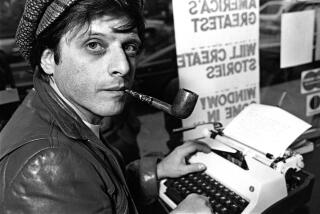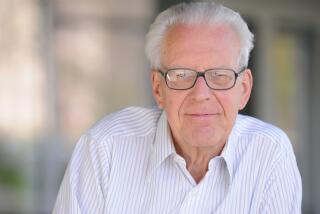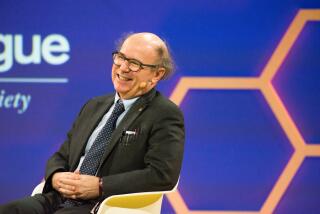‘Wars have retarded the progress of our society by at least 1,000 years. We must find a new way.’ : A Lifetime of Paying Homage to Einstein
- Share via
The Einstein-Steen Sticks and Stones Library isn’t like any other in Los Angeles County. Tucked away on a small street in Tujunga, it is the compact, five-room home of 88-year-old Otto A. Steen, retired construction foreman, sailor and pilot, full-time pacifist and Albert Einstein aficionado.
“I took the name ‘Sticks and Stones’ because that’s about all I had when I started,” Steen said.
But that was a long time ago. Steen, a slight, bespectacled man, said those who come to his house these days are usually impressed. Steen likes to step back and gauge the reaction on the first-time visitor’s face as he or she takes in the visual pandemonium of the living room.
More than 1,000 books fill two floor-to-ceiling rows of shelves against one wall, and by power of mob rule have commandeered nearly every other shelf, counter and table in the room. The walls are a collage of newspaper clippings, photographs, letters, post cards, certificates and portraits reflecting the varied events and interests in Steen’s life. Little bare wall is left. But, from the miscellany, two themes emerge: Steen’s lifelong work in the peace movement and his interest in the work and philosophy of the late physicist Einstein.
Vine on Ceiling
An outdoor vine that “must have grown in through a crack in the wall, quite some time ago,” has traversed the ceiling several times, clinging to the exposed beams. The plant’s hanging leaves provide an unruly framework for the 29 portraits mounted along one of the beams depicting, in chronological order, some of history’s greatest mathematicians, from Descartes to Einstein. Facing them, near the ceiling on an opposite wall, are 15 more great minds, from Copernicus to Einstein. Altogether, the house contains more than 160 pictures of Einstein.
Although Steen has lived in this house for only 13 years, he said he has been “collecting this junk for 80 years.”
The guest bedroom sports similar decor, with the addition of a 4-foot-tall portrait of Einstein hanging from a free-standing rack. Steen uses this and other props for a lecture on the life and work of Einstein that he occasionally gives for community groups. He has also made displays for three Pasadena libraries about the man he often refers to as “the greatest thinker of all time.”
Longtime Interest
Steen first became interested in Einstein during the early part of this century, when the physicist’s controversial scientific theories began to receive worldwide attention. Steen also liked Einstein’s philosophical beliefs, which paralleled his own commitment to work for world peace.
“That,” he said, pointing to a framed, handwritten letter, “is from Mrs. Pauling, wife of Linus Carl Pauling, the only man ever to win two unshared Nobel Prizes.” In the letter, the scientist’s wife thanks Steen for his volunteer work in 1961 for the Conference Against the Spread of Nuclear Weapons.
“I’ve been doing volunteer work for 50 years. That’s one of the reasons I’m broke,” Steen said with a laugh. A certificate of completion from the Peace Corps hangs nearby. Steen was one of the oldest people ever to complete the training course, though he was never sent anywhere.
A widower for 30 years, Steen lives alone. His adopted daughter, a former Valley College English literature professor, is a lecturer at George Washington University in Washington, D.C.
Checks to Charities
Steen picked up a bundle of canceled personal checks. They were all made out to charities, ranging from famine-relief organizations to peace groups.
“Of course, I didn’t start writing these yesterday,” Steen said. “These checks date back over the past 65 years.” There were more than 800 checks.
He laid the checks on a table next to a stack of scrapbooks. The top one contained the envelopes from correspondence that came in from around the world about 20 years ago, when Steen sent 101 letters to peace groups in 101 countries.
“I’ve been involved in the peace movement all my life, especially since 1921, when Einstein came to this country. He was a great promoter of peace,” Steen said.
One of the walls in Steen’s bedroom looks like an oversized chalkboard from a math class. Neatly drawn directly on the wall with wide-tipped felt markers are mathematical diagrams, puzzles and formulas.
Circle for Calculation
“Do you know what this one is?” Steen asked enthusiastically, pointing to a circle two feet in diameter and intersected by a handful of straight lines.
“It was used to calculate the speed of light,” he said. He traced the lines with his finger, explaining the principles involved. Steen took obvious pleasure in going through a few more of the equations, translating the riddles into simple English.
“But I am not a mathematician,” Steen said, sheepishly glancing at pictures of famous men of numbers amid the equations on the wall. “The computations of Einstein are above my head.”
In the backyard is a large open patio. On its brick floor Steen has painted a group of concentric ovals that represent the orbits of the planets in our solar system. Guests have written initials and dates on many of the individual bricks. A line of numbers along two perpendicular sides of the patio forms a grid with which Steen catalogues the location of each initialed brick. The guest is then issued a certificate, numbered and signed by Steen, stating the location of his or her brick. The current total is 413.
One Signatory
William Moore, author of “The Philadelphia Experiment,” is one such guest.
“That’s a unique arrangement he’s got back there,” Moore said. “It’s an interesting way of keeping track of his visitors. But then, he’s a unique gentleman.”
Most of the guests have been friends or friends of friends, Steen said. Moore, for example, met Steen because his aunt is Steen’s next-door neighbor. During the summer Steen occasionally is host at an informal dinner on the patio, and previous guests will bring new ones. Steen will invite them to sign in.
The license of Steen’s car reads: 99 EMC2. (The EMC2 is a shortened version of one of Einstein’s most famous equations; the 99 is the atomic number of the radioactive element einsteinium, discovered in the debris of the first large hydrogen bomb explosion.)
Back inside the house, Steen explained the meaning of the Latin phrase “ alia tentanda via est ,” which appears on the guests’ certificates for their bricks and in numerous places around the house.
‘A New Way’
“It translates,” he said, “to ‘a new way must be found.’ And it is a very true statement.
“The world is full of crime and strife. We have half the people wanting to kill the other half, and half of each group couldn’t tell you why. Wars have retarded the progress of our society by at least 1,000 years. We must find a new way.”
In 1977, Steen visited Moscow as one of eight delegates from the Society for Cultural Relations USA/USSR, an association that, among other functions, organizes tour groups between the two nations.
“I have relatives, you just mention Russia and their blood pressure changes,” Steen said. “Ignorance is tragic. Education is the only way.”
The myriad books in Steen’s library all show signs of thoughtful reading. Newspaper and magazine articles relating to material in the books are tucked between the pages or taped to the inside covers. The pages have markings all over them. Sentences are underlined; names are circled.
Of all the pictures, books and memorabilia in the Einstein-Steen Sticks and Stones Library, Steen’s favorite item is a book. “Here it is,” he said after scanning a shelf that holds more than 60 books by or about Einstein. The title reflects Steen’s two passions: “Einstein on Peace.”
More to Read
Sign up for Essential California
The most important California stories and recommendations in your inbox every morning.
You may occasionally receive promotional content from the Los Angeles Times.













